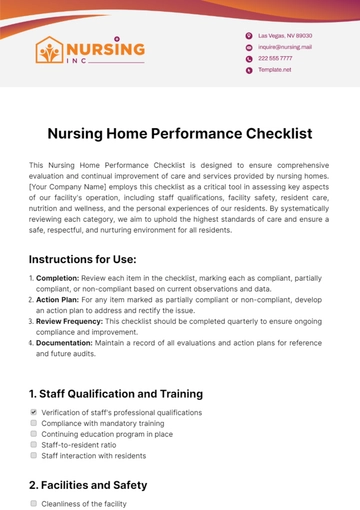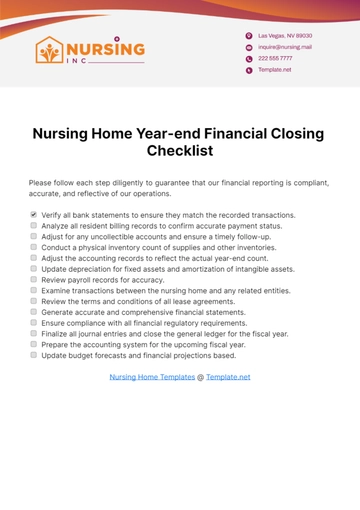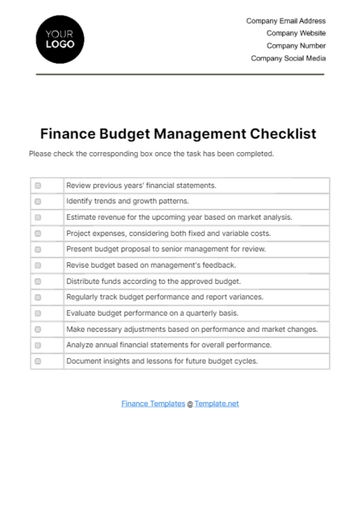Free Nursing Home Residents Disaster Preparedness Checklist

Tick off each box as you complete the necessary preparations to ensure you've addressed all essential precautions. Your proactive approach to disaster readiness is crucial for safeguarding your safety and well-being.
Emergency Kit
Ensure you have a three-day supply of easy-to-eat, non-perishable food items in your room.
Have at least one gallon of water per person per day stored in your room.
Keep a seven-day supply of medications in your possession, along with any necessary medical supplies.
Store a flashlight with extra batteries in an easily accessible location in your room.
Have a battery-operated or hand-crank radio in your room to receive emergency updates.
Maintain personal hygiene items such as toothbrush, toothpaste, soap, and hand sanitizer in your room.
Keep a first aid kit with bandages, antiseptic wipes, and other necessary medical supplies in your room.
Communication Plan
Maintain an updated emergency contact list with phone numbers for family members, friends, and healthcare providers.
Establish a designated meeting place within the nursing home in case of evacuation.
Keep a list of important contacts in your wallet or purse at all times.
Discuss your communication plan with nursing home staff to ensure they have updated contact information for your loved ones.
Medical Information
Keep a list of current medications, dosages, and any known allergies in your possession.
Have copies of important medical documents, such as health insurance cards and advance directives, readily available.
Provide nursing home staff with your medical history, including information about chronic conditions and recent treatments.
Ensure nursing home staff have contact information for your primary care physician and specialists.
Inform nursing home staff of any special instructions or medical alerts for emergency responders.
Mobility Aids and Equipment
Ensure your mobility aids (e.g., walker, cane, wheelchair) are easily accessible and in good working condition.
Keep spare batteries or chargers for motorized equipment in your possession.
Consider having a lightweight, portable wheelchair or transport chair for evacuation purposes.
Label your mobility aids with your name and room number for easy identification.
Inform nursing home staff of any special assistance or equipment you may need during an evacuation.
Evacuation and Safety Procedures
Familiarize yourself with the nursing home's evacuation plan and emergency procedures posted in common areas.
Know the designated evacuation routes and assembly areas within the nursing home.
Follow instructions from nursing home staff and emergency responders during an evacuation.
Participate in evacuation drills organized by the nursing home to ensure familiarity with procedures.
Stay calm and assist others who may need help during an evacuation.
- 100% Customizable, free editor
- Access 1 Million+ Templates, photo’s & graphics
- Download or share as a template
- Click and replace photos, graphics, text, backgrounds
- Resize, crop, AI write & more
- Access advanced editor
Prepare residents for emergencies with the Nursing Home Residents Disaster Preparedness Checklist Template available on Template.net! This editable and customizable solution ensures that residents are well-equipped to handle various emergency situations. Customize the checklist using the AI Editor Tool to address disaster scenarios, ensuring the safety and security of residents!
You may also like
- Cleaning Checklist
- Daily Checklist
- Travel Checklist
- Self Care Checklist
- Risk Assessment Checklist
- Onboarding Checklist
- Quality Checklist
- Compliance Checklist
- Audit Checklist
- Registry Checklist
- HR Checklist
- Restaurant Checklist
- Checklist Layout
- Creative Checklist
- Sales Checklist
- Construction Checklist
- Task Checklist
- Professional Checklist
- Hotel Checklist
- Employee Checklist
- Moving Checklist
- Marketing Checklist
- Accounting Checklist
- Camping Checklist
- Packing Checklist
- Real Estate Checklist
- Cleaning Checklist Service
- New Employee Checklist
- Food Checklist
- Home Inspection Checklist
- Advertising Checklist
- Event Checklist
- SEO Checklist
- Assessment Checklist
- Inspection Checklist
- Baby Registry Checklist
- Induction Checklist
- Employee Training Checklist
- Medical Checklist
- Safety Checklist
- Site Checklist
- Job Checklist
- Service Checklist
- Nanny Checklist
- Building Checklist
- Work Checklist
- Office Checklist
- Training Checklist
- Website Checklist
- IT and Software Checklist
- Performance Checklist
- Project Checklist
- Startup Checklist
- Education Checklist
- Home Checklist
- School Checklist
- Maintenance Checklist
- Planning Checklist
- Manager Checklist
- Wedding Checklist
- Vehicle Checklist
- Travel Agency Checklist
- Vehicle Inspection Checklist
- Interior Design Checklist
- Backpacking Checklist
- Business Checklist
- Legal Checklist
- Nursing Home Checklist
- Weekly Checklist
- Recruitment Checklist
- Salon Checklist
- Baby Checklist
- Equipment Checklist
- Trade Show Checklist
- Party Checklist
- Hospital Bag Checklist
- Evaluation Checklist
- Agency Checklist
- First Apartment Checklist
- Hiring Checklist
- Opening Checklist
- Small Business Checklist
- Rental Checklist
- College Dorm Checklist
- New Puppy Checklist
- University Checklist
- Building Maintenance Checklist
- Work From Home Checklist
- Student Checklist
- Application Checklist





























